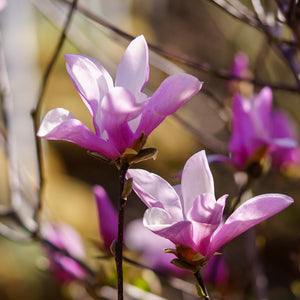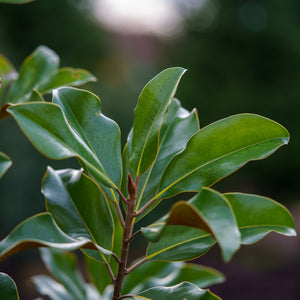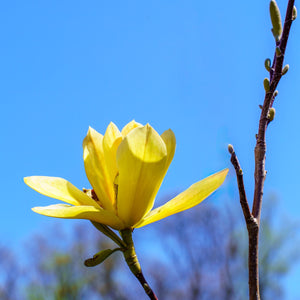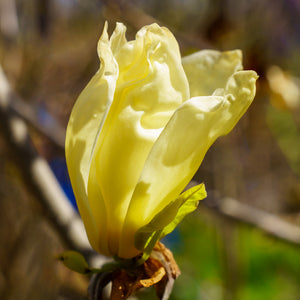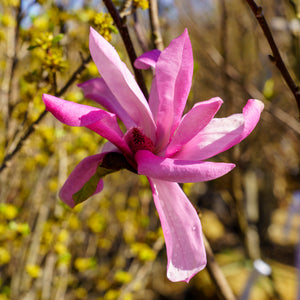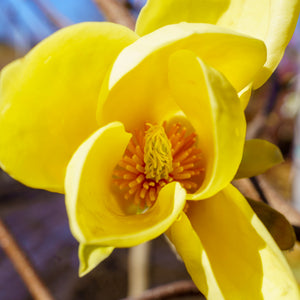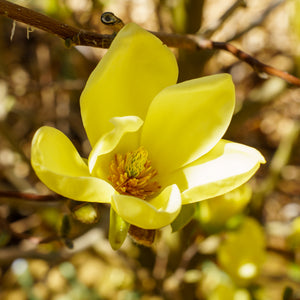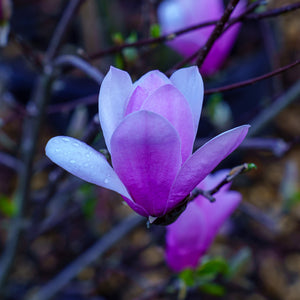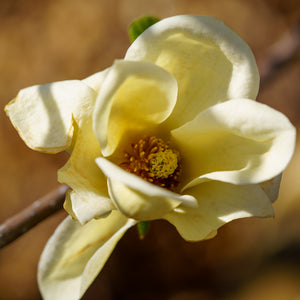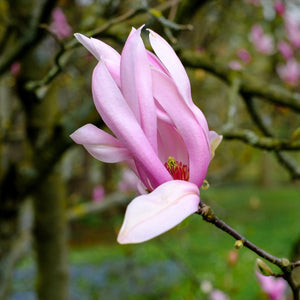The Magnolia Guide
Magnolia trees are known for their large, showy flowers that bloom in early spring or summer, depending on the species. The flowers come in shades of white, pink, purple, and yellow, and have a strong, sweet fragrance. Magnolia trees can grow up to 80 feet tall and have a spreading, rounded canopy. The leaves are large, glossy, and leathery, and some species have a unique silvery underside. Magnolia trees are popular ornamental trees and are often planted in parks and gardens for their beauty and fragrance.
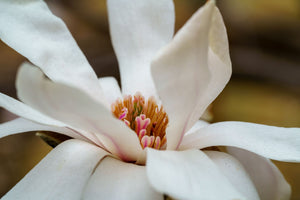
About
Magnolia, belonging to the Magnoliaceae family, is a diverse genus of flowering trees renowned for their captivating presence and ecological significance. This remarkable group encompasses various recognized species found across North America and other temperate regions.
Magnolias are characterized by their elegant form and the large, fragrant flowers that adorn their branches. These magnificent blooms are a defining feature, particularly during the spring. As the growing season progresses, magnolia's foliage transforms through different shades of green, ensuring year-round appeal.
Magnolia's role in local ecosystems is of great importance, as it provides sustenance and shelter to diverse wildlife. Its nectar-rich flowers attract a wide range of pollinators, and the unique fruit structures serve as a valuable food source for birds and other animals.
Magnolia's versatility in adapting to various soil types and environmental conditions, coupled with its moderate growth rate, positions it as a favored choice for both ornamental landscaping and ecological restoration.
Whether you plant Magnolia as a stunning ornamental tree or incorporate it into larger landscape designs, its beauty and ecological contributions make it an exceptional addition to any outdoor environment.
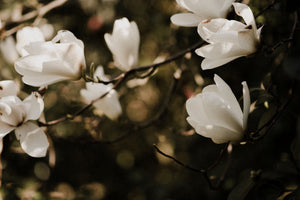
Planting
Magnolias have specific planting requirements to ensure their successful establishment and growth. Here are some general guidelines for planting and caring for magnolia:
Soil: Magnolias thrive in well-drained soil that is rich in organic matter. They prefer slightly acidic soil with a pH between 5.5 and 6.5. Before planting, prepare the site by loosening the soil and incorporating compost or organic matter to improve drainage and enhance soil fertility.
Sunlight: Magnolias generally prefer full sun to partial shade. Choose a location that receives at least six hours of direct sunlight each day for optimal growth. While they can tolerate partial shade, providing more sunlight generally results in better flowering.
Watering: Adequate watering is crucial for the initial establishment of magnolia. Water deeply immediately after planting, and continue to provide regular irrigation throughout the first year. Water deeply and thoroughly once or twice a week, adjusting the frequency based on rainfall and soil moisture levels. It's important to ensure the soil remains consistently moist but not waterlogged, as waterlogged soil can lead to root rot.
Mulching: Apply a layer of organic mulch, such as wood chips, bark, or compost, around the base of your magnolia. Mulch helps conserve moisture, suppress weed growth, and regulate soil temperature. Make sure to keep the mulch a few inches away from the trunk to prevent excess moisture buildup.
Pruning: Magnolias generally require minimal pruning. Remove any dead, damaged, or crossing branches to maintain a strong and balanced structure. Prune during late winter or early spring while the plants are still dormant, before new growth emerges.
By following these basic planting and care guidelines, you can ensure the successful establishment and healthy growth of your magnolia, allowing them to thrive and bring beauty to your landscape for years to come.
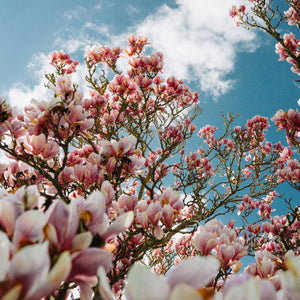
Care
Magnolias demand specific care to ensure their optimal growth and health. Here are some general guidelines for the care of magnolias:
Watering: Magnolias, especially when newly planted, require regular and deep watering to establish their root systems. Provide about one inch of water per week, adjusting based on rainfall and climate conditions. During periods of drought or hot weather, be prepared to water more frequently to maintain consistent soil moisture. Ensure the soil remains moist, not waterlogged.
Pruning: Magnolias, in general, don't necessitate extensive pruning. However, you should regularly remove dead, damaged, or crossing branches to maintain the tree's overall health and aesthetics. Shaping can be done as needed to achieve the desired size and form. Prune during late winter or early spring, when the tree is dormant and before new growth emerges. Always use clean, sharp pruning tools to minimize the risk of injury to the tree. Deadheading spent flowers can encourage new growth and, in some cases, a second round of blooming.
Fertilizing: Applying the right fertilizer can stimulate healthy growth and profuse flowering in magnolias. Utilize a balanced, slow-release fertilizer during the spring or early summer, following the recommended application rates and schedule as directed by the manufacturer. Caution should be exercised not to over-fertilize, which can damage the tree's roots. When in doubt, it's better to use less fertilizer to avoid overfeeding.
Soil and Sunlight: Magnolias thrive in well-drained, moist soil and full sun exposure. While they are adaptable to various soil types, proper drainage is essential for their best growth. Additionally, adding mulch around the base of the tree can help conserve moisture and stabilize soil temperature.
Pests and Diseases: Although magnolias are generally resistant to pests and diseases, it's wise to monitor for common issues like scale insects, aphids, and fungal diseases. If any signs of damage or disease appear, address them promptly with suitable insecticides or fungicides to prevent further problems.
By following these fundamental care instructions, your magnolia tree will flourish, providing beauty, seasonal interest, and a delightful presence in your garden for many years to come.
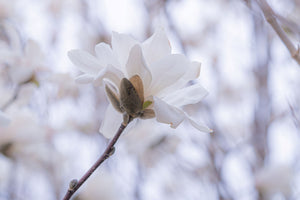
How To Use
Magnolias offer versatility and can be used in various ways to enhance your landscape. Here are some recommendations based on their characteristics:
Focal Point: Magnolias have a remarkable presence, making them an ideal choice as a focal point in your landscape. Plant a single magnolia tree in an open area to showcase its elegant form and captivating blossoms. Alternatively, create a breathtaking visual impact by planting multiple magnolia trees together, enhancing their collective beauty.
Shade Provider: With their broad canopies and abundant leaves, magnolia trees provide excellent shade. Plant them strategically near outdoor seating areas, patios, or decks to create a cool and comfortable space where you can relax and enjoy the outdoors during hot summer days.
Windbreak: Magnolias, with their sturdy growth and thick branches, can serve as an effective windbreak. Plant them in a row to shield your garden, home, or outdoor living spaces from strong winds, providing a natural barrier and protection.
Privacy Screen: Utilize the dense foliage of magnolia trees to create a natural privacy screen in your landscape. Plant them in a row along your property line to establish an attractive and functional barrier that enhances both privacy and aesthetics.
Wildlife Habitat: Magnolias contribute to the overall biodiversity of your garden by attracting various wildlife species. Birds and other animals are drawn to the blossoms, which serve as a valuable source of nectar, and the shelter provided by magnolia trees. Create a welcoming habitat by planting magnolia trees and enjoy the sight and sounds of wildlife flourishing in your outdoor space.
When selecting magnolia trees for your landscape, consider their growth rate and environmental requirements. Ensure they are planted in areas that receive full sun or partial shade and provide well-drained soil. With their elegant form, captivating blossoms, and functional benefits, magnolia trees are an exceptional addition that will enhance the beauty and functionality of your outdoor environment.
Conclusion
Magnolias are a captivating and versatile addition to any landscape. Their remarkable presence, enchanting blossoms, and cultural significance make them a highly desirable choice for various outdoor settings. By adhering to proper planting and care practices, you can enjoy the beauty and benefits of magnolias in multiple ways, whether it's creating a picturesque garden or providing a colorful backdrop in your backyard. Whether you choose to showcase their elegance as a focal point or incorporate them into a larger landscape design, magnolia trees offer endless possibilities to enhance the allure of your outdoor space. With dedication and care, you can create a breathtaking landscape that will bring you lasting joy for years to come.

